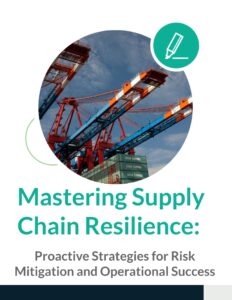Effective vendor management is crucial for maintaining operational efficiency and managing complex multilayer supply chains. Whether you’re a seasoned executive or new to the role, understanding and developing strategic supplier relationships can significantly impact your organization’s bottom line. In this guide, we will explore the key elements of effective vendor management, emphasizing the importance of cultivating strong supplier relationships, minimizing risks, and evaluating vendor performance. We will discuss strategies for developing and nurturing strategic supplier partnerships that enhance your business’s success. Our coverage will include best practices in communication, performance monitoring, contingency planning, and diversification, ensuring a holistic approach to vendor management.
Let’s dive in.
The Importance of Vendor Management
Effective vendor management is an important component of ensuring transparent internal operations and maintaining control over your business. It helps you anticipate challenges while providing insights on how and where to adapt to meet those expectations. Effective vendor management is a complex process of coordinating and overseeing multiple suppliers, their service level agreements SLAs, and ensuring you are getting what they have committed to delivering. Effectively managed vendor relationships yield significant benefits, including improved cost management, adherence to project timelines, and the ability to meet commitments to your customers.
Vendor management is not just about negotiating the best prices; it’s about creating partnerships that drive mutual growth. Building a network of reliable suppliers can enhance your organization’s agility, allowing you to respond quickly to market changes and customer demands.
Building Strong Supplier Relationships
Open Communication Channels
Communication is the foundation of any strong relationship, and vendor relationships are no different. Establishing open and transparent communication channels with your suppliers helps build trust and ensures that both parties are on the same page.
Regular meetings and check-ins can help address any issues before they escalate. Utilizing technology such as vendor management software can streamline communication and provide a centralized platform for sharing information and updates.
Clear communication also involves setting expectations from the outset. Ensure that your suppliers understand your business goals, standards, and timelines. This alignment will help you achieve better outcomes and foster a collaborative environment.
Performance Monitoring
Monitoring supplier performance is essential for maintaining high standards and ensuring that your suppliers meet your expectations. Implementing a robust performance monitoring system allows you to track key metrics such as delivery times, quality, and cost.
Regular performance reviews can help identify areas for improvement and provide opportunities for feedback. By working together to address any issues, you can strengthen your supplier relationships and drive continuous improvement.
Performance monitoring also involves recognizing and rewarding suppliers for their achievements. Acknowledging their efforts can motivate them to maintain high standards and foster a positive working relationship.
Effective Contract Management
Contracts are the backbone of any vendor relationship, outlining the terms and conditions of the partnership. They serve as legally binding agreements that protect the interests of both parties and ensure that expectations are clearly defined. Effective contract management involves ensuring that contracts are not only clear and comprehensive but also strategically aligned with your broader business objectives and goals.
Negotiating favorable terms requires a deep understanding of your needs and the ability to balance cost with quality and service. This means being well-prepared, conducting thorough research on market standards, and knowing the value that each vendor brings to the table. It’s also important to include clauses that address potential risks, such as changes in pricing, supply chain disruptions, or compliance requirements, and outline procedures for resolving disputes to minimize conflicts in the future.
Regularly reviewing and updating contracts is important to ensure vendors are meeting agreed-upon terms. This practice helps ensure that contracts remain relevant and reflect any changes in your business operations, market conditions, or regulatory landscape. By adopting a proactive approach to contract management, organizations can prevent misunderstandings, strengthen vendor relationships, and foster an atmosphere of collaboration and trust, ultimately contributing to a smoother and more efficient partnership.
Managing Risks in Vendor Relationships
Contingency Planning
Risk management is a critical aspect of vendor management, especially in today’s rapidly changing business environment. Developing comprehensive contingency plans for potential disruptions can significantly help in mitigating risks and ensuring the continuity of supply chains. This process involves a systematic approach, starting with identifying potential risks such as natural disasters, supplier failures, or geopolitical events. Once these risks are identified, it is essential to assess their potential impact on your operations, including financial implications, delivery timelines, and customer satisfaction.
Creating effective strategies to address these risks is paramount. Contingency planning should not only include identifying alternative suppliers to replace primary vendors in case of an emergency but also consider backup inventory that can be quickly mobilized when needed. This ensures that you can continue operations without major interruptions. Additionally, flexible logistics arrangements, such as multiple shipping options or partnerships with third-party logistics providers, can provide further resilience against unexpected disruptions.
By preparing for the unexpected, businesses can minimize disruptions and maintain operational efficiency. This proactive stance can prove invaluable in safeguarding against supply chain interruptions that could otherwise lead to lost revenue or damage to reputation.
Moreover, it is crucial to regularly review and update your contingency plans to reflect any changes in your business environment, supplier relationships, or market conditions. This ongoing evaluation helps ensure that your plans remain effective and relevant in the face of new challenges. By fostering a culture of preparedness and adaptability, you can enhance your organization’s resilience and overall ability to respond swiftly to unforeseen challenges, ultimately ensuring long-term success.
Diversification
Relying on a single supplier for critical components can be risky, especially in today’s volatile market. If that supplier encounters issues—whether due to financial instability, natural disasters, or supply chain disruptions—it can significantly impact your operations. Therefore, diversifying your supplier base is a proactive strategy that can help spread risk and ensure that you have multiple sources for essential materials and services, ultimately safeguarding your business continuity.
Diversification involves several key steps. First, it requires identifying and qualifying new suppliers that meet your standards for quality, reliability, and cost-effectiveness. This may involve conducting thorough research, requesting samples, and visiting potential suppliers to assess their capabilities firsthand. Once you’ve identified suitable options, building strong relationships with these new suppliers is crucial. This can include negotiating favorable terms, engaging in regular communication, and fostering a collaborative atmosphere that encourages transparency and trust.
Integrating these new suppliers into your existing supply chain is another vital aspect of the diversification process. This might involve updating your logistics strategies, adjusting inventory management practices, and ensuring that all stakeholders within your organization are aligned and informed about the changes. By doing so, you can enhance your flexibility and reduce the impact of potential disruptions, creating a more resilient supply chain overall.
However, it’s essential to maintain a balance between diversification and managing the complexity that comes with multiple suppliers. Juggling various relationships and coordinating different order processes can introduce challenges, such as increased administrative workload and potential communication gaps. To navigate these complexities, implementing a strategic approach is crucial. This may include utilizing supply chain management software, conducting regular reviews of supplier performance, and setting clear guidelines for engagement with each supplier. By carefully managing these dynamics, you can achieve the benefits of diversification while maintaining control over your supply chain. This strategic balance will ultimately position your business for sustained success and adaptability in an ever-changing marketplace.
Continuous Improvement
Managing risks in vendor relationships is a multifaceted endeavor that also involves fostering a culture of continuous improvement. By actively encouraging your suppliers to innovate and enhance their processes, you not only boost their performance but also contribute significantly to your business’s overall success. This collaborative spirit can lead to the development of new products, improved quality, and more efficient service delivery, all of which can set your business apart in a competitive marketplace.
Regularly reviewing and analyzing supplier performance data is crucial in this process, as it can help identify specific opportunities for improvement. This may include metrics related to delivery times, quality control, and cost efficiency. By working closely with your suppliers to implement strategic changes based on these insights, you can drive mutual growth and create a stronger partnership that is beneficial for both parties.
Continuous improvement is not just a one-time initiative; it requires an ongoing, collaborative approach. Both you and your suppliers need to be committed to achieving common goals and fostering an environment that encourages open communication and feedback. This partnership can lead to innovative solutions, enhanced operational efficiencies, and ultimately, a significant enhancement of your competitive advantage in the marketplace. By prioritizing continuous improvement, you set the foundation for long-term success and resilience in an ever-evolving business landscape.
Vendor Performance Metrics
On-Time Delivery
On-time delivery is a critical metric for assessing supplier performance. Reliable delivery times ensure that your operations run smoothly and meet customer expectations. Tracking delivery performance can help identify trends and address any issues promptly.
Implementing performance targets and regularly reviewing delivery data can help ensure that your suppliers meet your expectations. By working together to address any challenges, you can enhance reliability and strengthen the relationship.
Recognizing and rewarding suppliers for consistently meeting or exceeding delivery targets can motivate them to maintain high standards. This positive reinforcement can drive continuous improvement and foster a collaborative environment.
Quality
Quality is another essential metric for evaluating supplier performance. High-quality materials and services are crucial for maintaining your product standards and meeting customer expectations.
Implementing quality control processes and regularly reviewing quality data can help ensure that your suppliers meet your standards. Addressing any issues promptly and working together to improve quality can enhance the relationship and drive better outcomes.
Recognizing and rewarding suppliers for consistently delivering high-quality products can motivate them to maintain high standards. This positive reinforcement can drive continuous improvement and foster a collaborative environment.
Cost
Cost is a critical factor in supplier performance, affecting your bottom line and overall profitability. Tracking and analyzing cost data can help identify trends and opportunities for cost savings.
Negotiating favorable terms and regularly reviewing pricing can help ensure that you achieve the best value for your money. Working together with your suppliers to identify cost-saving opportunities can enhance the relationship and drive mutual growth.
Recognizing and rewarding suppliers for helping you achieve cost savings can motivate them to maintain competitive pricing. This positive reinforcement can drive continuous improvement and foster a collaborative environment.
Conclusion
Developing and maintaining strategic supplier relationships is crucial for achieving operational efficiency and gaining a competitive edge. By focusing on clear communication, performance monitoring, and effective contract management, you can build strong partnerships that drive mutual growth.
Managing risks through contingency planning and diversification can enhance your resilience and ability to respond to challenges. Implementing robust performance metrics for on-time delivery, quality, and cost can help ensure that your suppliers meet your expectations and contribute to your success.
By fostering a culture of continuous improvement and collaboration, you can achieve long-term strategic relationships that provide a competitive advantage. Invest in your supplier relationships today and elevate your business to new heights. For a more personalized approach, connect with one of our consultants today.







